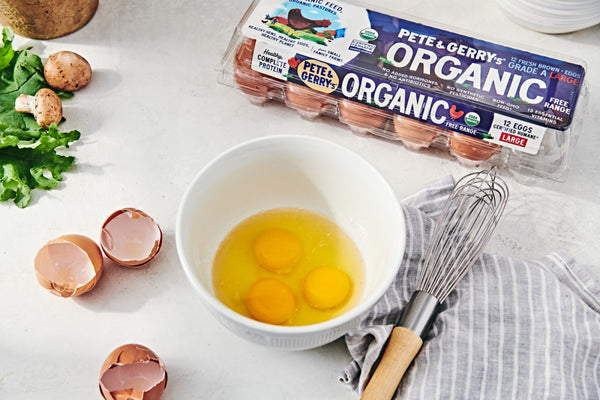
Here at Pete and Gerry’s, eggs are central to what we do. But like all food, this seemingly simple ingredient doesn’t exist in a vacuum. Food is political, personal, and inextricably tied to everything from culture to religion. Eggs are no exception. Over the years, we’ve amassed a collection of recipes, some coming to us from our farm families’ recipe boxes passed down from generation to generation, and others created by our network of brand ambassadors.
As we’ve shared these recipes with you, we have also developed a food philosophy pertaining to language, culture, and representation. In the past, these policies were simply discussed and taught internally. But recently, our consumers have expressed interest in learning more, and we're happy to have passionate voices join this conversation. We can't guarantee that we have always or will always make you proud with the manner in which we discuss food, but we do promise that we write and speak with intention, actively work to educate ourselves on an ongoing basis, and welcome all suggestions. Please review and leave your thoughts in the comments below!
Language matters
A mindful approach to life aligns nicely with the free range, organic values that we hold so dearly. In the same way that we cultivate genuine, compassionate relationships with our farmers and their flocks, we try to be intentional in choosing the recipes that we share. When we write about recipes, language matters. Words have power, and taking a conscious approach to our copywriting is a major part of our food philosophy.
Since the early days of our recipe collection, we have actively tried to support healthy relationships with food at every opportunity. This includes both physical and mental well-being, in which food plays an important role. The health of our hens and the land have always been priorities for us, and showing the same care and consideration for the well-being of our consumers, whatever that looks like for each individual, is just as important. We respect every person's choice when it comes to food, and we try to reflect balance and avoid tacking negative emotions or descriptions onto certain recipes or ingredients (like "cheat day" recipes, for example).
In crafting our recipe descriptions, we set out not only to provide a straightforward overview that gives our readers and consumers a glimpse into the ingredients, steps, and difficulty level of the recipe in question, but also to pay homage to the history and origins of that recipe. However popular and “mainstream” they may be, a bubbling pan of shakshuka or a bowl of ramen topped with jammy shoyu tamago (soy sauce eggs) are dishes with particular histories and origins. For us, removing a recipe from its context does not do justice to the dish. Whether it’s a nod to the origins of the dish or a deeper dive into its history, we strive to acknowledge the context in which any given recipe in our collection came to be.
When it comes to naming recipes from various countries and cultures, we have made the deliberate decision to include both the traditional recipe name and a descriptive recipe title for ease of searching. In many cases, our recipes stray from tradition, but we still feel it’s important to pay homage to the original. For example: cilbir, a Turkish egg and yogurt dish, doesn’t traditionally include avocado relish—but to omit “cilbir” from the title would be to overlook and overwrite a dish rooted in Turkish history and culture. In cases where a recipe name has multiple spellings, we consult multiple sources before choosing one.
 Cilbir (Turkish eggs with harissa butter) is a savory yogurt dish typically served with Aleppo pepper butter. In this particular version, the infused butter is swapped for harissa butter and the dish is served with a very nontraditional herbed avocado relish.
Cilbir (Turkish eggs with harissa butter) is a savory yogurt dish typically served with Aleppo pepper butter. In this particular version, the infused butter is swapped for harissa butter and the dish is served with a very nontraditional herbed avocado relish.
Culture matters
As our recipe collection continues to grow, we're making an intentional effort to diversify our offerings, adding globally inspired and culturally significant recipes when possible. You may rightly ask, why don't you stick to what you know? Our collection began as a handful of recipes from our partner farmers. The majority of these recipes fell into the category of American cuisine, passed down from our partner farmers' families for generations. When we turned to bloggers and recipe developers in the food space in order to grow our recipe collection, our request was simple: write what you know. And by the sheer fact that eggs are present in most cultures across the globe, our increasingly diverse network of brand ambassadors has developed recipes ranging from Korean to Mexican. In this way, we are sticking to what we know: eggs. And at the same time, we're creating a platform for our partners to share the egg dishes that are near and dear to their hearts, whether those recipes are considered "in our lane" or not.
Another reason why we feel it's important for our recipe collection to reflect the true diversity of egg dishes around the globe is because our consumers come from a diverse mix of cultures, too—and so does the population of the United States, where we sell our eggs. Catering exclusively to white Americans would not only hurt our business, but would alienate those who are underrepresented, including BIPOC (Black, Indigenous, and People of Color). To put it simply: Most cultures use eggs, so we strive to ensure that those cultures are represented in our recipes.
 Huevos ahogados is a Mexican dish consisting of eggs gently poached in a smooth red salsa made with guajillo chiles, chile de arbol, Roma tomatoes, and Mexican oregano. This is the version that our partner Isabel Eats, a first-generation Mexican American, grew up with.
Huevos ahogados is a Mexican dish consisting of eggs gently poached in a smooth red salsa made with guajillo chiles, chile de arbol, Roma tomatoes, and Mexican oregano. This is the version that our partner Isabel Eats, a first-generation Mexican American, grew up with.
Representation matters
Ensuring that a diverse group of cultures and cuisines is represented in our recipes matters, but deciding who develops those recipes is equally important. For our brand ambassador program, we seek out bloggers and recipe developers with varied voices, perspectives, and backgrounds. We believe that recipes rooted in a particular culture are best represented when written by a person of that culture. When this is not possible due to the size of our small but mighty partner program, we're careful to consider a partner's familiarity with the dish. In other words, did they grow up eating the dish? Did they travel to the country of origin and learn how to make the dish there? For example, shoyu tamago is a Japanese dish, but our partner Omnivore's Cookbook took inspiration from her upbringing in Beijing as well as her travels in Japan while developing her own version. Whenever possible, we ensure that there is a cultural or personal connection between dish and developer before moving forward with a recipe.
 Shoyu tamago, or soy sauce eggs, have become increasingly common in Asian fusion dishes found across the United States. Although shoyu tamago is technically a Japanese dish, Omnivore's Cookbook was inspired by both her upbringing in Beijing and her travels in Japan while developing this particular recipe.
Shoyu tamago, or soy sauce eggs, have become increasingly common in Asian fusion dishes found across the United States. Although shoyu tamago is technically a Japanese dish, Omnivore's Cookbook was inspired by both her upbringing in Beijing and her travels in Japan while developing this particular recipe.
However, we also believe that food connects us all in pretty magical ways. More than ever, we find ourselves using food to travel to places we can't physically visit right now. And so, when we have a partner who is interested in writing about a dish with cultural ties that has since become more mainstream (think shakshuka), we don't strictly prohibit them from creating it for us. This is a bit of a gray area, and is discussed at length internally on a case-by-case basis to determine if it feels appropriate (or appropriated).
Frequently asked questions
Aside from technical questions about the recipes we share, we often get questions about authenticity, our brand ambassador program, and how recipes are chosen. You'll find answers to some of these questions below.
Are your recipes authentic?
In most cases, no. Even when a recipe is very close to what's considered "authentic," we're careful not to throw that label on it without research and critical thought. Food can be incredibly personal and subjective: even a single dish can have dozens of iterations, names, and preparations, which all begs the question, what is authenticity? Some of the recipes in our collection have been Americanized to a degree, calling for ingredient substitutions or kitchen tools that are more accessible in the United States than the ingredients and tools that might be used in the dish's country of origin. But whether it's a substitution or a major, nontraditional addition to the recipe that would by no means be considered authentic, we take care to point out deviations from authenticity in our recipes. This space we've created is not meant to be a platform for strict authenticity, but rather for celebrating the differences and subjectivity that make food so universal.
 Carbonara is a traditional Italian dish with a reputation for being done "wrong" in American kitchens due to varying personal tastes and ingredient availability in the United States. For this recipe, we chose to include options for the meat and cheese; guanciale or bacon, and Romano or Parmesan.
Carbonara is a traditional Italian dish with a reputation for being done "wrong" in American kitchens due to varying personal tastes and ingredient availability in the United States. For this recipe, we chose to include options for the meat and cheese; guanciale or bacon, and Romano or Parmesan.
How do you choose your recipes?
We choose our recipes based on a number of factors. In most cases, we ask our partners to share multiple ideas that they're passionate or excited about, and we go from there. We're always looking for opportunities to add culturally diverse recipes to our website, while also seeking out recipes that we know our consumers love, such as keto and low carb recipes, Whole30 recipes, and paleo recipes. We also take seasonality into account, striving to share recipes that use seasonal ingredients at the appropriate time of year. And of course, we love sharing our takes on trending and popular recipes every now and then.
 Over the years, we've learned that many of our consumers follow a keto diet or are interested in low carb dishes, so we've made a point to share recipes that fit into every lifestyle. The proof is in the pudding (or cheesecake?): this keto Instant Pot lemon cheesecake is our most popular recipe of all time!
Over the years, we've learned that many of our consumers follow a keto diet or are interested in low carb dishes, so we've made a point to share recipes that fit into every lifestyle. The proof is in the pudding (or cheesecake?): this keto Instant Pot lemon cheesecake is our most popular recipe of all time!
Who develops your recipes?
Although our brand ambassador program is small, it's constantly growing. While we do some recipe development in-house, the majority of our recipes come to us from our partners, including:
- Butter Be Ready: Quin is a self-taught home cook with a passion for sharing easy, seasonally inspired, no-fuss recipes, many of which are inspired by her West Indian familial background in St. Thomas, one of the US Virgin Islands.
- Isabel Eats: Isabel is a first-generation Mexican American and no stranger to authentic home-cooked Mexican food, which she was raised on. Today, she's proud to share the recipes and traditions that shaped her childhood.
- Occasions by Shakira: Shakira is a self-proclaimed serial holiday celebrator. Her recipes are geared towards families with young children, as well as her fellow parents and party enthusiasts.
- Omnivore's Cookbook: Maggie's formal adventures in the culinary world began during her travels in Japan after an upbringing in Beijing, China. On any given week, her kitchen is filled with meals ranging from traditional Chinese cuisine to western and fusion dishes.
We hope that this overview of our food philosophy here at Pete and Gerry's has provided some helpful insight to the behind-the-scenes of our recipe collection. If there's a topic that we have not addressed here, we encourage you to reach out to us in the comments or send an email to familyfarmteam@peteandgerrys.com. Food is one of the few things that connects everyone on the planet, and we're always grateful for the opportunity to hear your perspective on a dish, recipe requests, and questions that pave the way for a productive conversation.










